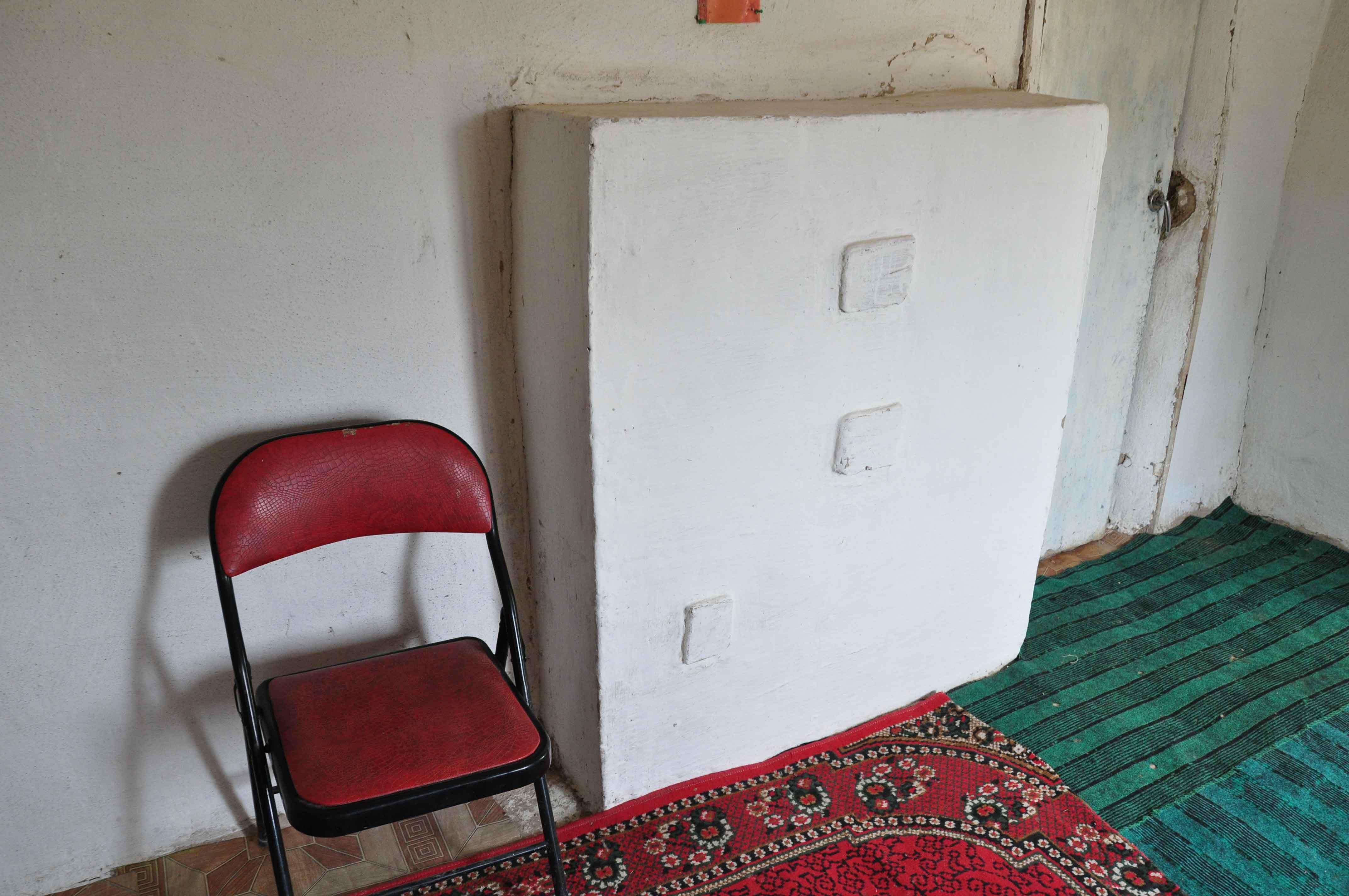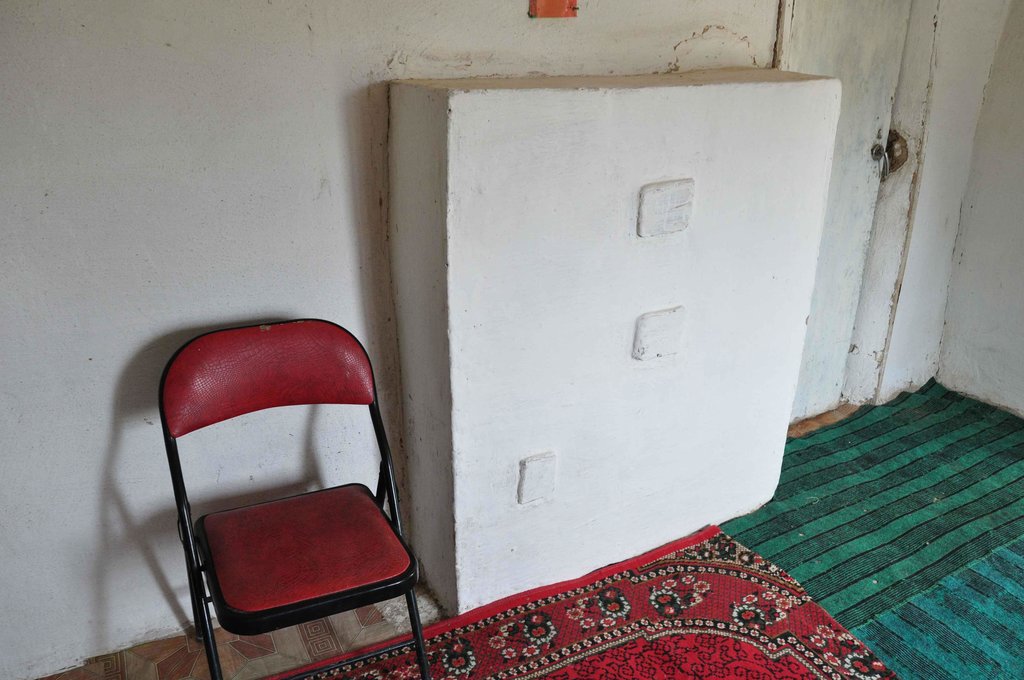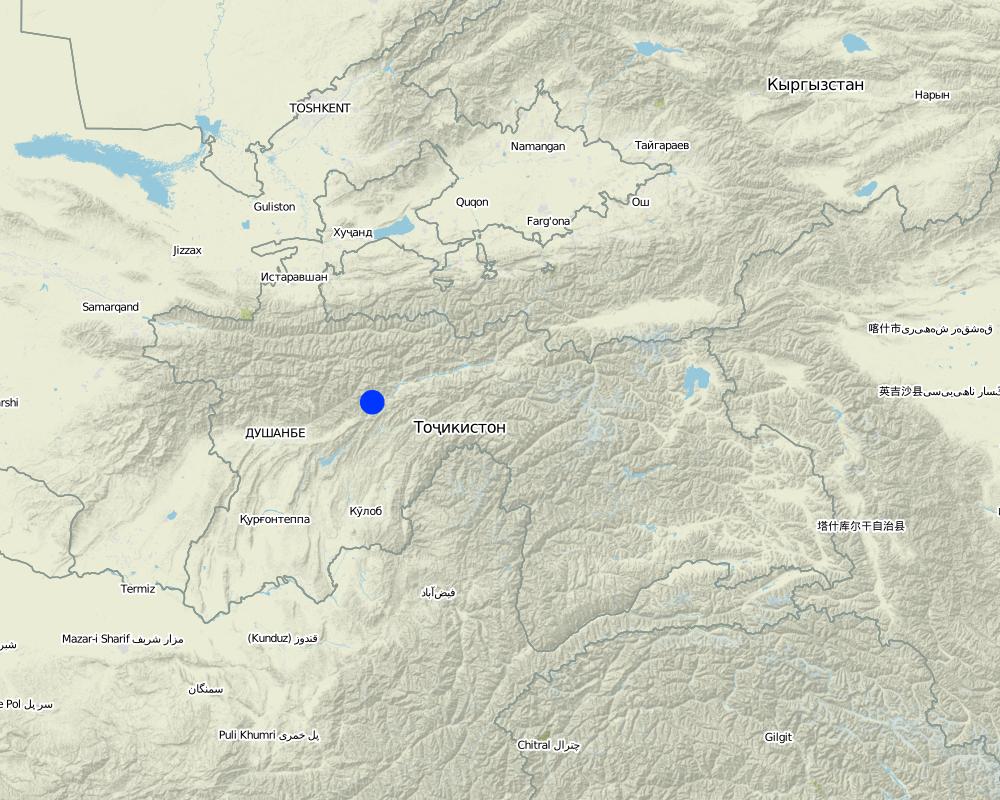Two Room Stove [塔吉克斯坦]
- 创建:
- 更新:
- 编制者: shane stevenson
- 编辑者: –
- 审查者: David Streiff, Alexandra Gavilano
technologies_1518 - 塔吉克斯坦
查看章节
全部展开 全部收起1. 一般信息
1.2 参与该技术评估和文件编制的资源人员和机构的联系方式
SLM专业人员:
Pochoev Mirzokurbon
mirzo_pochoev@camp.tojikiston.com
CAMP
塔吉克斯坦
有助于对技术进行记录/评估的机构名称(如相关)
CAMP - Central Asian Mountain Partnership (CAMP - Central Asian Mountain Partnership) - 吉尔吉斯斯坦1.3 关于使用通过WOCAT记录的数据的条件
(现场)数据是什么时候汇编的?:
11/07/2011
编制者和关键资源人员接受有关使用通过WOCAT记录数据的条件。:
是
1.5 请参阅有关SLM方法的问卷
2. SLM技术的说明
2.1 技术简介
技术定义:
A brick stove that is built into the existing internal wall, that will heat the two rooms and can be used for cooking.
2.2 技术的详细说明
说明:
The 2-room stove is a brick based structure that filters hot air into a second room, hence maximising the heating potential of the fuel. The basic stove is built of fire bricks, house bricks, cement and coated with a natural mix of straw and mud. It is a traditional concept based upon former soviet stoves, that was modernised and adapted to improve the energy efficiency, and make use of the materials that are available to the people. It is able to burn coal, wood, and tapac, and is designed to reduce the amount of natural resources used to meet the household energy needs.
Purpose of the Technology: The purpose of the 2-room stove is to replace the traditional cast iron pig style of stove, with a more modern and energy efficient stove that can be used effectively for cooking and the heating of two rooms. The 2-room stove is designed to filter the hot air between the rooms and the use the bricks as a thermal sink for heat retention. As most of the houses are made of mud bricks, the heat from the stove will conduct through the walls, which will act as radiators to emit warmth into the room. The 2-room stove also means that cooking activities can be conducted inside the house in a smoke free environment.
Establishment / maintenance activities and inputs: The stove requires basic training in construction by a skilled technician, however after a three day training course the local trades people are able to build their own stoves with limited supervision. The stove is constructed from 45 fire bricks and 400 household bricks, the hot plate and stove doors are bought second hand from the markets, and metal bars are used to reinforce the structure. There are two smoke vents in the wall between the two rooms to allow the smoke to filter its way along the snake like chimney until it vents through the roof. The final structure is coated in straw and mud which acts as an insulation layer.
Natural / human environment: There is a high reliance on natural resources in Shahtuti Bolo. The average family burns several tons of tapac (straw dung mix) and wood each year. The surrounding mountain area is sparsely vegetated and does not even provide enough fuel for the village during the harsh winter months. This is supplemented by buying wood from the neighbouring villages. One tapac weighs one kilo, this is organic matter that can no longer be used for soil enhancement, but for fuel purposes. It is estimated that the 2-room stove will reduce the amount of fuel burnt by 20-40% depending upon the household.
2.3 技术照片
2.5 已应用该技术的、本评估所涵盖的国家/地区/地点
国家:
塔吉克斯坦
区域/州/省:
Hakimi Jamoat, Nurobod
有关地点的进一步说明:
Regional Subordination of Tajikistan
Map
×2.6 实施日期
如果不知道确切的年份,请说明大概的日期:
- 不到10年前(最近)
2.7 技术介绍
详细说明该技术是如何引入的:
- 通过项目/外部干预
注释(项目类型等):
The two room stove is modernisation of a traditional design, therefore the concept is not new to the people.
3. SLM技术的分类
3.1 该技术的主要目的
- reduce energy
3.2 应用该技术的当前土地利用类型

牧场

定居点、基础设施
- 定居点、建筑物
注释:
The technology is implemented in the households
注释:
Major land use problems (compiler’s opinion): The over exploitation of natural resources that have lead to soil erosion and degradation of the soil structure.
Major land use problems (land users’ perception): The land has become increasingly unproductive over the last few decades. There is not enough pasture to feed our animals.
Constraints of settlement / urban
3.3 有关土地利用的更多信息
具体说明:
Longest growing period in days: 180Longest growing period from month to month: April - October
3.4 该技术所属的SLM组
- 节能技术
3.5 技术传播
具体说明该技术的分布:
- 均匀地分布在一个区域
如果该技术均匀地分布在一个区域上,请注明覆盖的大致区域。:
- 0.1-1 平方千米
注释:
The village of Shahtuti Bolo
3.6 包含该技术的可持续土地管理措施

结构措施
- S11:其它
注释:
Main measures: structural measures
3.7 该技术强调的主要土地退化类型

土壤水蚀
- Wt:表土流失/地表侵蚀
- Wg:冲沟侵蚀/沟蚀
- Wm:块体运动/滑坡

土壤风蚀
- Et:表土流失

化学性土壤退化
- Cn:肥力下降和有机质含量下降(非侵蚀所致)

生物性退化
- Bc:植被覆盖的减少
- Bh:栖息地丧失
- Bq:数量/生物量减少
注释:
Main type of degradation addressed: Wt: loss of topsoil / surface erosion, Wg: gully erosion / gullying, Wm: mass movements / landslides, Et: loss of topsoil, Cn: fertility decline and reduced organic matter content, Bc: reduction of vegetation cover, Bh: loss of habitats
Secondary types of degradation addressed: Bq: quantity / biomass decline
Main causes of degradation: soil management (Failure to use organic fertilisers), deforestation / removal of natural vegetation (incl. forest fires) (Removal of natural resources to meet local energy needs.), over-exploitation of vegetation for domestic use (as above), overgrazing (Areas became over grazed as productivity declined), disturbance of water cycle (infiltration / runoff) (removal of vegetation leads to increased run off from the mountain slopes.), poverty / wealth (There is a lack of money for investment), labour availability (Two thirds of the households in the village have people working abroad.), war and conflicts (There has been substantial political unrest in the area.)
Secondary causes of degradation: Heavy / extreme rainfall (intensity/amounts) (There is a perception that there are more extreme rainfall events.), population pressure (Popualtion in the area is increasing), education, access to knowledge and support services (Lack of knowledge on good land management.)
3.8 防止、减少或恢复土地退化
具体数量名该技术与土地退化有关的目标:
- 防止土地退化
- 减少土地退化
注释:
Main goals: mitigation / reduction of land degradation
Secondary goals: prevention of land degradation
4. 技术规范、实施活动、投入和成本
4.1 该技术的技术图纸
作者:
S. stevenson, CAMP Kuhiston, apt19 h 131 Rudaki ave, 734003, Dushanbe
4.2 技术规范/技术图纸说明
A simple view of the main part of the stove used for cooking. There are two cast iron doors, the lower is for air circulation and the upper is the combustion chamber for the fuel. There are two hot plates for cooking. The smoke travels from the fire vent towards the chimney and then through a 10cm sq hole to the brick structure on the other side. The smoke snakes it way around the the second structure which acts as a radiator as the bricks warm up. The smoke then returns into the chimney in the main room, heating the chimney as it vents.
Location: Shahtuti Bolo. Nurobod
Date: 13.07.2011
Technical knowledge required for field staff / advisors: high (The technical design requires a high level of knowledge)
Technical knowledge required for land users: moderate (With training the land user would be able to build their own two room stove)
Main technical functions: reduces the amount of dung and wood used as fuel.
Structural measure: 2-room stove
Construction material (other): fire bricks and regular house bricks, covered in mud are the main materials.
4.3 有关投入和成本计算的一般信息
具体说明成本和投入是如何计算的:
- 每个技术单元
指定单位:
Stove
具体说明成本计算所用货币:
- 美元
注明雇用劳工的每日平均工资成本:
4.00
4.4 技术建立活动
| 活动 | 措施类型 | 时间 | |
|---|---|---|---|
| 1. | Construction of stove | 结构性的 | any |
| 2. | None | None |
4.5 技术建立所需要的费用和投入
| 对投入进行具体说明 | 单位 | 数量 | 单位成本 | 每项投入的总成本 | 土地使用者承担的成本% | |
|---|---|---|---|---|---|---|
| 劳动力 | Construction of stove | Persons/day | 6.0 | 5.333333 | 32.0 | 100.0 |
| 设备 | Tools | pieces | 5.0 | 4.0 | 20.0 | |
| 施工材料 | Bricks | bricks | 400.0 | 0.225 | 90.0 | |
| 施工材料 | Fire bricks | bricks | 45.0 | 1.4 | 63.0 | |
| 施工材料 | Metal bar | bars | 5.0 | 3.4 | 17.0 | |
| 施工材料 | Fire cement | cub m | 3.0 | 8.333333 | 25.0 | |
| 施工材料 | Ceramic tiles | tiles | 24.0 | 1.0 | 24.0 | |
| 施工材料 | Metal cooking plates | plates | 1.0 | 63.0 | 63.0 | |
| 施工材料 | Stove doors | doors | 2.0 | 22.5 | 45.0 | |
| 其它 | Transports | vans | 1.0 | 50.0 | 50.0 | |
| 技术建立所需总成本 | 429.0 | |||||
注释:
Duration of establishment phase: 1 month(s)
4.6 维护/经常性活动
| 活动 | 措施类型 | 时间/频率 | |
|---|---|---|---|
| 1. | Cleaning the stove | 结构性的 | annually |
4.7 维护/经常性活动所需要的费用和投入(每年)
| 对投入进行具体说明 | 单位 | 数量 | 单位成本 | 每项投入的总成本 | 土地使用者承担的成本% | |
|---|---|---|---|---|---|---|
| 劳动力 | Cleaning the stove | Persons/day | 1.0 | 4.0 | 4.0 | 100.0 |
| 技术维护所需总成本 | 4.0 | |||||
注释:
The costs are based upon 2011 prices and are based on constructing only one stove.
4.8 影响成本的最重要因素
描述影响成本的最决定性因素:
The main cost is the fire bricks. These have to be transported from the capital. However, in some regions of Tajikistan, materials are available from stoves that were constructed several decades ago which could be reused.
5. 自然和人文环境
5.1 气候
年降雨量
- < 250毫米
- 251-500毫米
- 501-750毫米
- 751-1,000毫米
- 1,001-1,500毫米
- 1,501-2,000毫米
- 2,001-3,000毫米
- 3,001-4,000毫米
- > 4,000毫米
农业气候带
- 半干旱
Thermal climate class: temperate
5.2 地形
平均坡度:
- 水平(0-2%)
- 缓降(3-5%)
- 平缓(6-10%)
- 滚坡(11-15%)
- 崎岖(16-30%)
- 陡峭(31-60%)
- 非常陡峭(>60%)
地形:
- 高原/平原
- 山脊
- 山坡
- 山地斜坡
- 麓坡
- 谷底
垂直分布带:
- 0-100 m a.s.l.
- 101-500 m a.s.l.
- 501-1,000 m a.s.l.
- 1,001-1,500 m a.s.l.
- 1,501-2,000 m a.s.l.
- 2,001-2,500 m a.s.l.
- 2,501-3,000 m a.s.l.
- 3,001-4,000 m a.s.l.
- > 4,000 m a.s.l.
说明该技术是否专门应用于:
- 不相关
5.3 土壤
平均土层深度:
- 非常浅(0-20厘米)
- 浅(21-50厘米)
- 中等深度(51-80厘米)
- 深(81-120厘米)
- 非常深(> 120厘米)
土壤质地(表土):
- 粗粒/轻(砂质)
表土有机质:
- 低(<1%)
如有可能,附上完整的土壤描述或具体说明可用的信息,例如土壤类型、土壤酸碱度、阳离子交换能力、氮、盐度等。:
Soil fertility is low - medium
Soil drainage / infiltration is poor
Soil water storage capacity is low-medium
5.4 水资源可用性和质量
地下水位表:
< 5米
地表水的可用性:
匮乏/没有
水质(未处理):
不良饮用水(需要处理)
关于水质和水量的注释和进一步规范:
Availability of surface water: is good for the village because there is a stream and medium for other areas which have access to te stream.
5.5 生物多样性
物种多样性:
- 低
5.6 应用该技术的土地使用者的特征
非农收入:
- 收入的10-50%
相对财富水平:
- 非常贫瘠
- 贫瘠
个人或集体:
- 个人/家庭
性别:
- 女人
- 男人
说明土地使用者的其他有关特征:
Land users applying the Technology are mainly disadvantaged land users
Difference in the involvement of women and men: Training is provided on he construction of the stove. This is only attended by men.
Population density: 50-100 persons/km2
Annual population growth: 2% - 3%
80% of the land users are poor and own 95% of the land.
20% of the land users are poor and own 5% of the land.
Off-farm income specification: 44 out of the 58 households are reliant on remittances from Russia, however all the families have livestock which they buy and sell in the local markets and a small household plot for vegetables.
5.7 应用该技术的土地使用者拥有或租用的平均土地面积
- < 0.5 公顷
- 0.5-1 公顷
- 1-2 公顷
- 2-5公顷
- 5-15公顷
- 15-50公顷
- 50-100公顷
- 100-500公顷
- 500-1,000公顷
- 1,000-10,000公顷
- > 10,000公顷
这被认为是小规模、中规模还是大规模的(参照当地实际情况)?:
- 小规模的
5.8 土地所有权、土地使用权和水使用权
土地所有权:
- 州
土地使用权:
- 社区(有组织)
注释:
Four people have the majority of the land user rights in a village of 58.
5.9 进入服务和基础设施的通道
健康:
- 贫瘠
- 适度的
- 好
教育:
- 贫瘠
- 适度的
- 好
技术援助:
- 贫瘠
- 适度的
- 好
就业(例如非农):
- 贫瘠
- 适度的
- 好
市场:
- 贫瘠
- 适度的
- 好
能源:
- 贫瘠
- 适度的
- 好
道路和交通:
- 贫瘠
- 适度的
- 好
饮用水和卫生设施:
- 贫瘠
- 适度的
- 好
金融服务:
- 贫瘠
- 适度的
- 好
6. 影响和结论性说明
6.1 该技术的现场影响
社会经济效应
生产
作物生产
木材生产
能源生产
注释/具体说明:
Improved cooking conditions i.e. no smoke.
收入和成本
工作量
其它社会经济效应
Demand on natural resources
注释/具体说明:
On average around 30% reduction
社会文化影响
健康状况
注释/具体说明:
Do not need to cook outside and improve the internal living conditions.
社区机构
注释/具体说明:
Leaves natural resources for the community benefit.
冲突缓解
注释/具体说明:
Helps prevent inter village conflicts over natural resources.
社会经济弱势群体的情况
注释/具体说明:
The project is targeted at the most vulnerable in the community.
Livelihood and human well-being
注释/具体说明:
It has reduced the time, effort and money spent on fuel whcih can be up to 50% of the household's budget in extreme cases. It has improved the heating in the household and created a smoke free environment for cooking.
生态影响
土壤
土壤覆盖层
生物多样性:植被、动物
生物量/地上C
注释/具体说明:
Reduction in the burning of dung.
6.3 技术对渐变气候以及与气候相关的极端情况/灾害的暴露和敏感性(土地使用者认为的极端情况/灾害)
渐变气候
渐变气候
| 季节 | 气候变化/极端天气的类型 | 该技术是如何应对的? | |
|---|---|---|---|
| 年温度 | 增加 | 好 |
气候有关的极端情况(灾害)
气象灾害
| 该技术是如何应对的? | |
|---|---|
| 局地暴雨 | 好 |
| 局地风暴 | 好 |
气候灾害
| 该技术是如何应对的? | |
|---|---|
| 干旱 | 好 |
水文灾害
| 该技术是如何应对的? | |
|---|---|
| 比较和缓的(河道)洪水 | 好 |
其他气候相关的后果
其他气候相关的后果
| 该技术是如何应对的? | |
|---|---|
| 缩短生长期 | 好 |
注释:
The stove is able to take other fuel sources in the event that natural resources are not available.
6.4 成本效益分析
技术收益与技术建立成本相比如何(从土地使用者的角度看)?
短期回报:
消极
长期回报:
非常积极
技术收益与技术维护成本/经常性成本相比如何(从土地使用者的角度看)?
短期回报:
中性/平衡
长期回报:
积极
注释:
There is a high initial outlay in the building materials and labour costs, but once the two room stove is constructed it only requires annual cleaning which can be done via hatches already included in the design.
6.5 技术采用
- 1-10%
如若可行,进行量化(住户数量和/或覆盖面积):
10 households in an area of 0.1 - 1 km2 (ca. 596 habitants)
在所有采用这项技术的人当中,有多少人是自发地采用该技术,即未获得任何物质奖励/付款?:
- 0-10%
注释:
100% of land user families have adopted the Technology with external material support
Comments on acceptance with external material support: All land users given support have constructed a stove. The project will build a further 11 stoves in the local district for the most vulnerable families.
There is no trend towards spontaneous adoption of the Technology
Comments on adoption trend: To early in the project to say, but several memebers of the community are trained to build the stove.
6.7 该技术的优点/长处/机会
| 土地使用者眼中的长处/优势/机会 |
|---|
|
It keep the house warm and for longer. How can they be sustained / enhanced? Thermal insulation techniques and energy efficiency training may support reduced fuel use. |
| I do not have to cook outside in the winter months. |
| It is easy to clean. |
| 编制者或其他关键资源人员认为的长处/优势/机会 |
|---|
|
It improved the household heating system dramatically, as the previous cast iron stove does not retain the heat after the fire dies. How can they be sustained / enhanced? The room could be insulated using traditional techniques or modern materials that are starting to appear on the market. |
|
The brick design will retain the heat for several hours and will heat two rooms. How can they be sustained / enhanced? Doors and windows in the rooms could be sealed to prevent drafts. |
|
The stove will last for 25yrs with minimal maintenance. How can they be sustained / enhanced? If the stove became popular a small brick making factory could be established. |
6.8 技术的弱点/缺点/风险及其克服方法
| 土地使用者认为的弱点/缺点/风险 | 如何克服它们? |
|---|---|
| It is expensive, and I need an expert to help me. | Remittances could be used to fund the initial set up costs. |
| 编制者或其他关键资源人员认为的弱点/缺点/风险 | 如何克服它们? |
|---|---|
| There is a high initial investment that has required project funding. | Collective building of the stoves will reduce the cost. Micro-finance loans could be made available to help cover the initial costs. |
| The stove requires technical training in its construction. | A booklet could be produced to support self building of the stoves. |
链接和模块
全部展开 全部收起链接
无链接
模块
无模块





